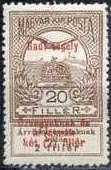Stamp: Mythical bird Turul flying over Crown of St. Stephen (Hungary 1914)
Mythical bird Turul flying over Crown of St. Stephen (Hungary 1914)
07 October (Hungary ) within release War Fund (I) goes into circulation Stamp Mythical bird Turul flying over Crown of St. Stephen face value 20+2 Hungarian fillér
| Stamp Mythical bird Turul flying over Crown of St. Stephen in catalogues | |
|---|---|
| Michel: | Mi:HU 153 |
Stamp is vertical format.
Also in the issue War Fund (I):
- Stamp - Mythical bird Turul flying over Crown of St. Stephen face value 20+2;
- Stamp - King Franz Josef (1830-1916) face value 1+0.02;
- Stamp - King Franz Josef (1830-1916) face value 2+0.02;
- Stamp - Mythical bird Turul flying over Crown of St. Stephen face value 10+2;
- Stamp - Mythical bird Turul flying over Crown of St. Stephen face value 25+2;
- Stamp - King Franz Josef (1830-1916) face value 5+0.02;
- Stamp - Mythical bird Turul flying over Crown of St. Stephen face value 1+2;
- Stamp - Mythical bird Turul flying over Crown of St. Stephen face value 2+2;
- Stamp - Mythical bird Turul flying over Crown of St. Stephen face value 3+2;
- Stamp - Mythical bird Turul flying over Crown of St. Stephen face value 5+2;
- Stamp - Mythical bird Turul flying over Crown of St. Stephen face value 6+2;
- Stamp - Mythical bird Turul flying over Crown of St. Stephen face value 12+2;
- Stamp - Mythical bird Turul flying over Crown of St. Stephen face value 16+2;
- Stamp - Mythical bird Turul flying over Crown of St. Stephen face value 30+2;
- Stamp - Mythical bird Turul flying over Crown of St. Stephen face value 35+2;
- Stamp - Mythical bird Turul flying over Crown of St. Stephen face value 50+2;
- Stamp - Mythical bird Turul flying over Crown of St. Stephen face value 60+2;
Stamp Mythical bird Turul flying over Crown of St. Stephen it reflects the thematic directions:
Myth is a genre of folklore consisting primarily of narratives that play a fundamental role in a society. For scholars, this is very different from the vernacular usage of the term "myth" that refers to a belief that is not true. Instead, the veracity of a myth is not a defining criterion
Birds (Aves), a subgroup of Reptiles, are the last living examples of Dinosaurs. They are a group of endothermic vertebrates, characterised by feathers, toothless beaked jaws, the laying of hard-shelled eggs, a high metabolic rate, a four-chambered heart, and a strong yet lightweight skeleton. Birds live worldwide and range in size from the 5 cm (2 in) bee hummingbird to the 2.75 m (9 ft) ostrich. They rank as the class of tetrapods with the most living species, at approximately ten thousand, with more than half of these being passerines, sometimes known as perching birds. Birds are the closest living relatives of crocodilians.
World War I or the First World War (28 July 1914 – 11 November 1918), also known as the Great War, was a global conflict between two coalitions: the Allies (or Entente) and the Central Powers. Main areas of conflict included Europe and the Middle East, as well as parts of Africa and the Asia-Pacific. There were important developments in weaponry including tanks, aircraft, artillery, machine guns, and chemical weapons. One of the deadliest conflicts in history, it resulted in an estimated 30 million military casualties, plus another 8 million civilian deaths from war-related causes and genocide. The movement of large numbers of people was a major factor in the deadly Spanish flu pandemic.
In British heraldry, a coronet is any crown whose bearer is less than sovereign or royal in rank, irrespective of the crown's appearance. In other languages, this distinction is not made, and usually the same word for crown is used irrespective of rank (German: Krone, Dutch: Kroon, Swedish: Krona, French: Couronne, etc.) In this use, the English coronet is a purely technical term for all heraldic images of crowns not used by a sovereign, and implies nothing about the actual shape of the crown depicted. A Coronet is another type of crown, but is reserved for the lower ranks of nobility like Marquesses and Marchionesses, Earls and Countesses, Barons and Baronesses, and some Lords and Ladies. The specific design and attributes of the crown or coronet signifies the hierarchy and ranking of its owner.




